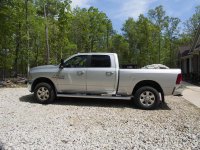In the end, I am glad to see the aluminum bodied F150 do well in this test and hope other manufacturers follow Ford's lead for increases in fuel economy and capacities. I almost purchased one with the ecoboost when I thought I wanted a heavy duty 1/2 ton. Then almost purchased a GM. Thankfully the dealers wanted too much for them and I purchased my diesel Ram 2500 instead with it greater capacities and am very satisfied. I would have been right at the upper limits with the HD half tons.
The other day I had an ~ 1 ton load of rock in the bed and the truck rode extremely well even with a higher percentage of the load behind the rear axle. And over this short 35 mile trip, the computer said I got the same fuel mileage as with an empty bed. With an aluminum body I would have even better mileage and carrying capacity.

The other day I had an ~ 1 ton load of rock in the bed and the truck rode extremely well even with a higher percentage of the load behind the rear axle. And over this short 35 mile trip, the computer said I got the same fuel mileage as with an empty bed. With an aluminum body I would have even better mileage and carrying capacity.

